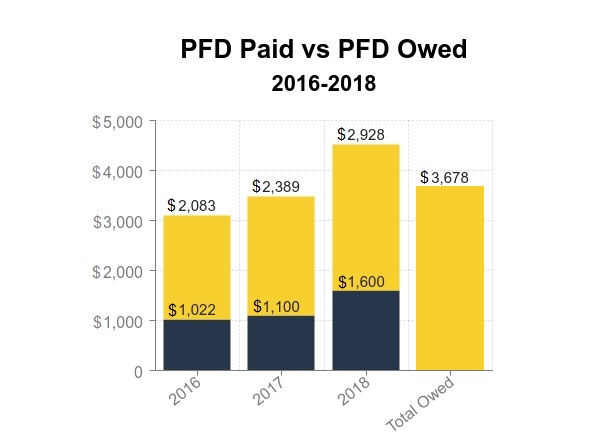January 17, 2019 (Juneau, Alaska) – Yesterday, Alaska Governor Michael J. Dunleavy held a press conference unveiling two Permanent Fund Dividend-related bills focused on restoring full dividends and repaying Alaskans monies owed for years 2016, 2017, and 2018 under historic PFD calculations.
Key Takeaways:
Governor Dunleavy believes we should view the PFD as a transfer under the historic calculations Alaskans have grown to trust and rely upon.
The bills work to fulfill that commitment by providing full back pay over three years, while also cementing full dividends through 2023 by prioritizing and authorizing the next four years of dividend payments. This removes the threat the PFD will once again be held as political ransom.
- SB23: An Act making special appropriations from the earnings reserve account for the payment of unpaid permanent fund dividends, and authorizing dividend payments through 2023.
- SB24: An Act directing the Department of Revenue to pay dividends to certain eligible individuals over the next three years.
Back Pay Eligibility:
Eligible individuals will be determined by the receipt of a prior year’s dividend and their eligibility for the current year’s dividend.
- To receive back pay ($1,061) in 2019; an applicant must have received a 2016 dividend and be eligible for a 2019 dividend.
- To receive back pay ($1,289) in 2020; an applicant must have received a 2017 dividend and be eligible for a 2020 dividend.
- To receive back pay ($1,328) in 2021; an applicant must have received a 2018 dividend and be eligible for a 2021 dividend.
PFD Paid vs PFD Owed:
According to the Permanent Fund Dividend Corporation, eligible Alaskans should have received $3,678 additional dollars during years 2016, 2017 and 2018 under the historic formula. Those funds – $2.3 billion in unpaid dividends – sit unspent in the Earnings Reserve Account.
2016:
Dividend Paid = $1,022
Historic Calculation = $2,083
Unpaid Dividend = $1,061
2017:
Dividend Paid = $1,100
Historic Calculation = $2,389
Unpaid Dividend = $1,289
2018:
Dividend Paid = $1,600
Historic Calculation = $2,928
Unpaid Dividend = $1,328
Total Unpaid Dividends for 2016, 2017, 2018 = $3,678

Additional Background:
The Alaska Permanent Fund was established – by constitutional amendment – to give future generations of Alaskans the opportunity to share in our states’ rich energy and mineral resources.
- Since 1982, Alaskans have grown to trust the balanced statutory formula in which the Permanent Fund Dividend was calculated and distributed.
- Alaskans overwhelmingly supported the existing PFD system, yet in 2016 the trust of Alaskans was broken and the PFD was cut in half by a stroke of a pen.
As a State Senator, Governor Dunleavy took numerous efforts to restore the PFD under its historical calculations – filing numerous bills and amendments to restore and protect the PFD.
- Governor Dunleavy has stated consistently that he believes the Alaska PFD should be restored and repaid.
- He has also made clear that any changes to the PFD must be authorized by a vote of the people.
The Governor’s back pay proposal does not expend new dollars, rather returns what Alaskans are lawfully owed. Meanwhile, opponents of restoring a full PFD and authorizing back pay continue to paint a false choice in an attempt to solidify a multi-billion dollar tax increase on Alaskan families.
Previous Statements:
“The PFD must be paid out according to the law, Alaskans must be paid back what the governor arbitrarily took from them, and future actions involving the PFD must be approved by voters.” – Governor Michael J. Dunleavy
“As your governor, I will follow the law and fully fund the PFD and inflation proofing.” – Governor Michael J. Dunleavy
“I believe the Permanent Fund belongs to the people of Alaska and support protecting the PFD in the Alaska Constitution where politicians can’t touch it,” – Governor Michael J. Dunleavy
“Eventually, the citizens of Alaska may decide to change the way the Permanent Fund is used. But the people themselves, not politicians, must make that decision for anyone to place trust in it.” – Governor Michael J. Dunleavy

